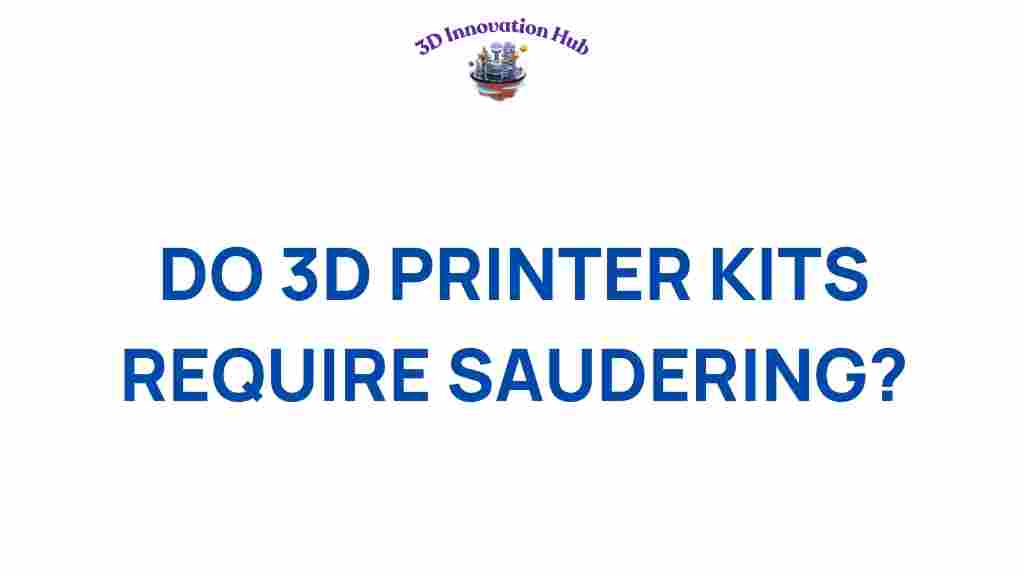Do 3D Printer Kits Necessitate Soldering?
3D printing has revolutionized the way we think about manufacturing and creative expression, allowing hobbyists and professionals alike to bring their ideas to life. One of the most popular ways to get started in this exciting field is by using 3D printer kits. However, a common question arises: do these kits necessitate soldering? In this article, we will unveil the truth about soldering in the context of 3D printer kit assembly, and we will explore what it means for DIY enthusiasts and technology lovers.
Understanding 3D Printer Kits
Before diving into the soldering debate, it’s essential to understand what 3D printer kits are. Typically, 3D printer kits come with all the necessary parts and instructions to assemble a 3D printer from scratch. These kits are appealing for several reasons:
- Customization: Building from a kit allows you to customize your printer according to your needs.
- Learning Experience: Assembling a printer can teach you about its inner workings.
- Cost-Effective: Kits are often cheaper than pre-assembled printers.
Now, let’s explore the assembly process and the role of soldering in it.
The Assembly Process of 3D Printer Kits
Assembling a 3D printer kit can be an exciting journey, and it typically involves several steps:
- Unboxing: Carefully unpack all components, ensuring no parts are damaged or missing.
- Reading Instructions: Go through the manual thoroughly to understand the assembly process.
- Gathering Tools: Prepare the necessary tools such as screwdrivers, pliers, and possibly a soldering iron.
- Assembling the Frame: Start building the frame by following the instructions provided.
- Installing Electronics: This step may involve connecting wires, sensors, and motors.
- Calibration: After assembly, calibrate the printer for optimal performance.
Does Soldering Play a Role?
The answer to whether soldering is necessary in assembling 3D printer kits is not a simple yes or no. It largely depends on the specific kit you choose. Let’s break down the scenarios:
1. Kits That Require Soldering
Some advanced 3D printer kits may require soldering for the following reasons:
- Custom Electronics: If you’re using custom circuit boards or components, soldering may be needed to connect wires.
- Upgrades: If you plan to upgrade your printer with advanced electronics, soldering could be part of the process.
- Repairs: In case of malfunctioning components, soldering might be necessary to replace or repair them.
2. Kits That Do Not Require Soldering
However, many 3D printer kits are designed for ease of assembly and do not require soldering at all. These kits often use:
- Plug-and-Play Components: Many modern kits come with pre-soldered parts, allowing for easy connections.
- Connector Systems: Kits may utilize connectors that make it simple to attach wires without soldering.
For hobbyists looking to avoid soldering, these kits are an excellent choice, allowing for a more straightforward assembly process.
Step-by-Step Guide to Assembling a 3D Printer Kit Without Soldering
If you have chosen a 3D printer kit that does not require soldering, here’s a step-by-step guide to help you through the assembly:
- Unpack and Organize: Lay out all parts and organize them for easy access.
- Frame Assembly: Follow the manual to construct the frame, typically using screws or brackets.
- Install the Print Bed: Attach the print bed and ensure it is level.
- Mount the Electronics: Secure the motherboard and other electronic components using screws.
- Connect the Wires: Use the connectors provided to attach wires to the motors and sensors.
- Install the Hotend and Extruder: Follow the instructions to install the hotend and extruder assembly.
- Calibrate the Printer: After assembly, perform the necessary calibrations for print quality.
Troubleshooting Common Issues
Even with a well-assembled 3D printer kit, issues may arise. Here are some common problems and troubleshooting tips:
- Printer Not Turning On: Check connections to the power supply and ensure all wires are securely connected.
- Prints Not Sticking to the Bed: Ensure the print bed is level and clean. Consider using adhesives like glue stick or hairspray.
- Extruder Jamming: Clean the nozzle and ensure the filament is feeding correctly.
- Misaligned Prints: Recalibrate the axes to ensure accurate movement.
If you encounter issues that are difficult to resolve, consulting forums, or communities like Reddit’s 3D printing community can provide valuable insights and solutions.
Conclusion
In conclusion, whether 3D printer kits necessitate soldering depends on the specific kit and the components included. While some kits may require soldering for custom electronics or repairs, many modern kits are designed for ease of use, allowing hobbyists to enjoy the innovation of 3D printing without the need for soldering. This accessibility makes 3D printing more approachable for DIY enthusiasts and technology lovers alike.
If you’re eager to dive into the world of 3D printing, choose a kit that aligns with your comfort level regarding assembly and soldering. Remember, the journey of building your own printer is as rewarding as the prints you will create!
For more information on 3D printing technology, you can explore this comprehensive guide.
This article is in the category and created by 3D Innovation Hub Team
